AI in Assessment Scale
What is the AI in Assessment Scale?
The AI in Assessment Scale supports instructors and students in navigating the responsible and transparent use of artificial intelligence in academic work. This tool will provide a common vocabulary and clear guidance on how, when, and to what extent AI tools may be used in assignments and other assessments.
By fostering shared understanding and open dialogue, the AI in Assessment Scale aims to promote academic integrity, enhance learning, and empower both educators and learners to make informed decisions about AI use in their courses.
How Does the Scale Work?
- Levels range from less AI permitted (Level 1) to more AI permitted (Level 6).
- Each level has an outline of how AI should be used and several examples.
- The icon and/or description will be shared on the assignment (e.g., in the introduction, header, or footer).
- Instructors choose the level for each assignment or other assessment (e.g., lab report, quiz, exam).
- Each assessment can have a different level.
The AI in Assessment Scale is licensed under a CC-BY-NC-SA International 4.0 license. This work is adapted from The AI Assessment Scale, by Perkins, Furze, Roe, & MacVaugh (2024), licensed under a CC-BY-NC-SA license.
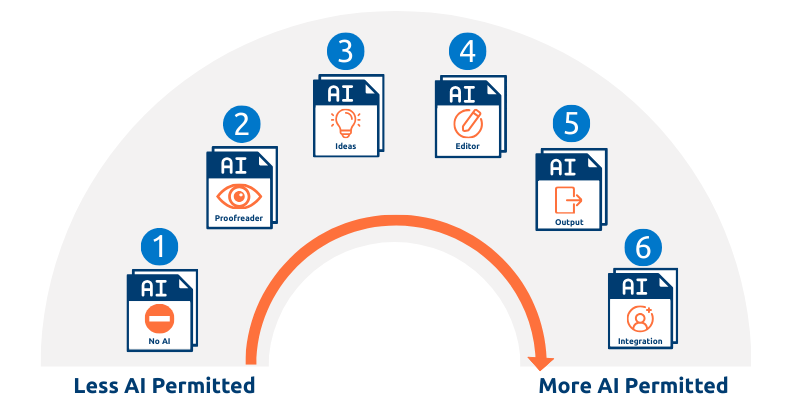
Levels in Detail
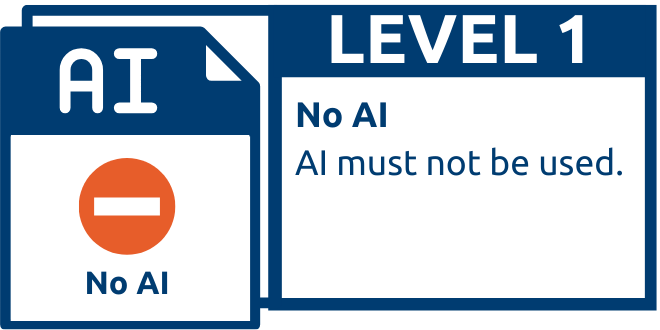 Description
Description
- The assignment requires you to demonstrate your learning without AI assistance.
- This is to ensure that you are relying solely on your own knowledge, understanding and skills to demonstrate your learning.
- You must not use AI at any point during the assignment.
- Any AI tools used in your academic work may result in academic misconduct.
Examples
A student completes an exit ticket during lecture using only pen and paper. They do not consult any resources, reference materials, or technology. Any spoken or live discussion contributions are based entirely on their own original thoughts, which may or may not be informed by prior knowledge or research.
A student completes a quiz or assignment that requires solving math equations, chemistry problems, or similar tasks independently. They are not permitted to consult any resources, use technology, or seek outside assistance; all solutions must be entirely their own work.
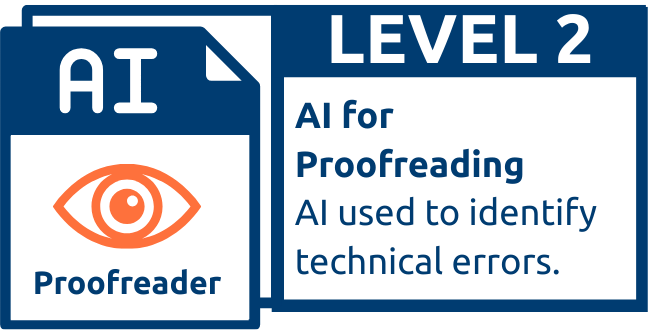 Description
Description
- The assignment requires you to demonstrate your learning while using AI to proofread your work.
- AI may assist in identifying and correcting technical errors such as spelling, punctuation, or grammatical mistakes, but AI cannot generate content.
- There is to be no AI content in the final submission of the assignment.
Example
A student in a nursing course writes a care plan assignment for a patient scenario provided in class. Before submitting, they paste their draft into an AI tool and ask it to check spelling, grammar, and punctuation. The AI highlights a few errors, such as inconsistent verb tenses and missing commas, and suggests clearer phrasing in one sentence. The student reviews these suggestions, accepts the ones that improve readability, and leaves the rest as is. They do not ask the AI to rewrite content or generate new material; every assessment, rationale, and intervention in the care plan is the student’s own work. The final submission contains only the student’s original writing, polished through AI-assisted proofreading.
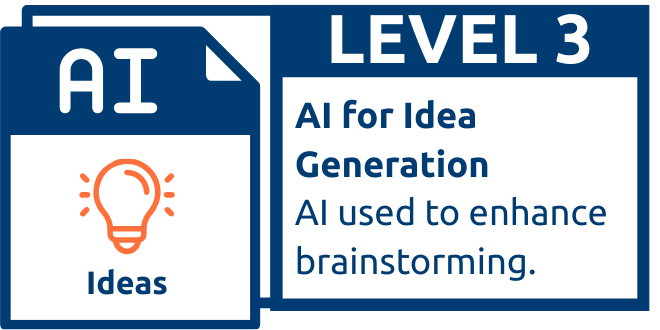 Description
Description
- The assignment requires you to demonstrate your learning while using AI for brainstorming and idea generation.
- You may use AI to enhance your own brainstorming/idea generation or in planning structure of the assignment.
- You are responsible for developing, refining and presenting your own arguments, analyses and conclusions without the use of AI.
- There is to be no AI content in the final submission of the assignment.
- You may be required to include evidence (e.g., drafts, citations or prompts) showing which AI technologies you used and where in your assignment.
Examples
A student uses AI to generate a list of potential topics for a course paper. They refine the initial suggestions, choose the strongest idea, and then organize their paragraphs and arguments independently. They conduct their own research and apply course knowledge to develop the final paper.
A student uses AI to help brainstorm common issues in public health and to draft a potential outline for a paper. Using this as a starting point, the student creates their own titles, headings, and subheadings, and then writes the paper themselves, incorporating research and analysis to demonstrate their learning.
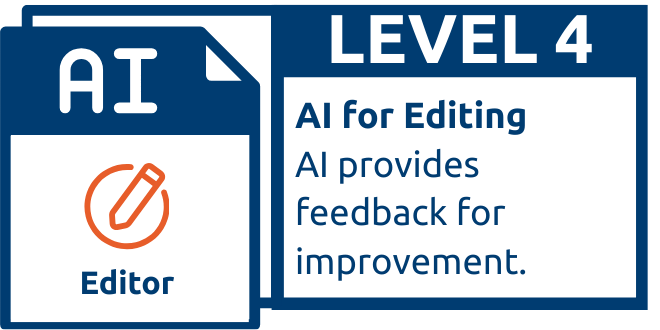 Description
Description
- The assignment requires you to demonstrate your learning while using AI for editing, refining and evaluating your work.
- AI may assist in reviewing the quality your drafts, including word choice, clarity, and effective expression of ideas.
- You must not use AI for creating new content.
- You may use AI to receive feedback on draft versions or identify areas for improvement of writing and structure of the written assessment.
- You are responsible for deciding if the suggestions are appropriate and then appropriately incorporating into your work. AI should not make revisions for you.
- You may be required to include evidence (e.g., drafts, citations or prompts) showing which AI technologies you used and where in your assignment or assessment.
Examples
A student completes a lab assignment and drafts their report for grading. Before submitting, they provide both the draft report and the rubric to an AI tool and ask: “Review my lab report using the rubric. What areas should I improve to achieve an A in each category? Provide me with a bulleted list.” AI highlights areas for improvement, such as clarity of results and stronger connections between data and conclusions. The student then decides which suggestions to apply, revises their work accordingly, and submits the improved report to Canvas along with a record of their AI use.
A student writes code for a programming assignment, but their program does not run properly. They ask an AI tool to review the code and explain potential errors or improvements. The AI suggests where bugs may be occurring and provides explanations of what could be done differently. The student evaluates these suggestions, decides which to implement, and makes the necessary corrections themselves. The final submission is their own corrected code, refined with AI feedback.
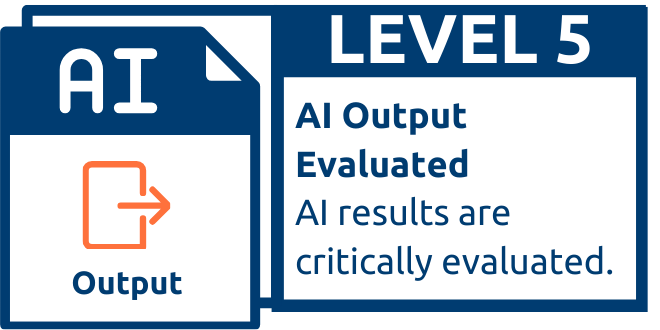 Description
Description
- The assignment requires you to demonstrate your learning while using AI to generate content and critically evaluate the results.
- AI may be used to create and/or perform: outlines, searches, drafts, notes, slides, analyses of data, counter-arguments, literature summaries, etc.
- Critical evaluation may include an analysis of accuracy, bias, relevance, citations, etc.
- AI may complete some parts of the assessment, but you must analyse and discuss the results and make decisions about what is accurate, useful, and relevant to demonstrate your learning.
- You may be required to include evidence (e.g., drafts, citations or prompts) showing which AI technologies you used and where in your assignment or assessment.
Examples
A student asks AI to create a simple Python program to check the contents of a spreadsheet. The student then reviews the program, makes corrections, and adds comments. They submit the program along with their comments and a copy of the prompts used to generate the program.
A student is writing a short literature review on the impact of social media on attention spans. They ask an AI tool to generate a list of recent studies and provide a short summary of key arguments. The AI provides a draft outline with some references. The student then critically evaluates the results: checking whether the references are real, whether the summaries are accurate, and whether there are any missing perspectives (e.g., studies showing positive effects of social media).
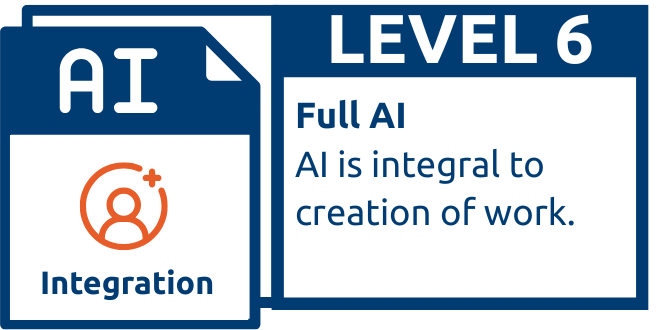 Description
Description
- AI is used as a collaborator to enhance your creativity and help you demonstrate your learning.
- AI acts as an assistant helping you organize your thoughts, integrate various viewpoints and present findings in a creative manner. It can help you draft outlines, suggest structure, or even provide initial content that you can build upon and refine.
- You may be required to include evidence (e.g., drafts, citations or prompts) showing which AI technologies you used and where in your assignment or assessment.
Examples
A graduate student in a Digital Education course develops a program that uses an LLM to help students create literature review outlines. They use AI to brainstorm ideas and generate a draft structure, but then refine it by adding academic integrity checkpoints and customizing the code themselves. The student evaluates the AI’s contributions, correcting errors and removing fabricated citations, and adds a creative feature requiring users to reflect on why they accepted or rejected AI suggestions. In their submission, they include prompts, examples, and a reflection to show how AI acted as a collaborator while they demonstrated critical thinking and originality.
A student is preparing a presentation on Indigenous approaches to environmental sustainability. They’ve already done their readings and group discussions, but they’re struggling with how to organize their ideas into a clear structure. They ask an AI tool to suggest different ways to outline the presentation and to recommend slide layouts. The AI generates three possible outlines. The student chooses one, adapts it, and adds their own examples and citations from course materials. They refine the visuals and design of the slides themselves, ensuring they highlight the most important points. In their submission, they include a short note describing how they used AI to generate initial outlines and how they customized the final version.